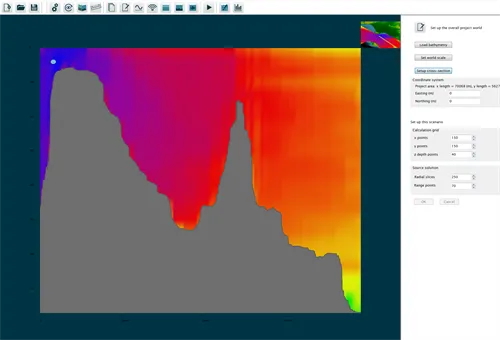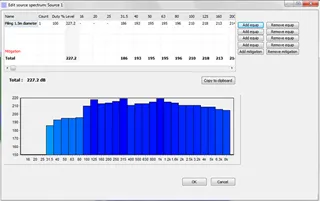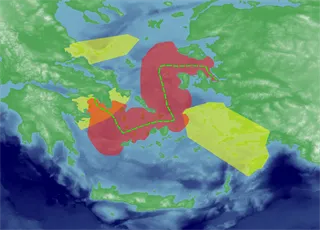dBSea - underwater noise prediction and visualization software
dBSea provides robust and accurate predictions of underwater noise levels for a wide range of environments and scenarios.
Main Features
dBSea was developed by acoustic professionals for acoustic professionals. A user-friendly interface allows for rapid modeling of problems, including data import and export, noise source input, definition of propagation characteristics, and export of results.

The model is represented in 3D and can be rotated and zoomed to easily navigate the problem environment and inspect predictions. Where previous analysis was limited to a single computational slice or spline, dBSea allows the entire problem environment to be modeled and analyzed.
Build 3D models by importing bathymetric data and placing noise sources in the environment. Each sound source can include devices selected from a standard or user-defined database, or can include recorded sounds. Noise mitigation methods may also be included. Users can control seabed and water properties including sound velocity (how the speed of sound changes with water depth), temperature, salinity and water currents at any point in the scene.

Calculate noise levels across your project area and display them in 3D. To examine the results in more detail, the levels can be plotted in cross-section, or detailed spectra can be extracted at any point in the 3D calculation area.
Levels are calculated in octave or third-octave bands. Three different solvers are provided, and users can choose different solvers for low-frequency and high-frequency ranges. Compare levels to the hearing thresholds of many common marine species or your own thresholds to come up with an overall dBht rating.
特殊功能

dBSea provides an easy way to export calculation results. The user can generate a calculation summary for each point in the 3D calculation area. The results are produced in a format that can be immediately transferred to other software such as MS Excel or Word.

Graphics export is available in several formats (JPG, PNG, GIF, PDF, SHP, ESRI GRID). Utilizing dBSea's 3D graphics capabilities, elegant report data can be easily created to display sound levels, areas of concern, and exclusion zones.
More information
About dBSea
Marshall Day Acoustics and Irwin Carr Consulting have developed dBSea, a powerful tool for predicting underwater noise in a variety of environments. dBSea is ideal for studying underwater acoustic problems involving single or multiple sources using a solver covering a wide frequency range. The software has a user-friendly interface and a clearly defined workflow for rapid development and modification of models. The 3D workspace clearly displays bathymetric data, noise sources and prediction results.

Technical Information
The solvers incorporated into dBSea for predicting underwater acoustic fields include the most popular computational methods in the underwater acoustics industry. Each different solver algorithm finds application with different types of problems, resulting in an overall package that covers many underwater acoustic scenarios, taking into account complex sound velocity profiles and sediment properties. dBSea incorporates source directivity for airgun seismic survey predictions and plots output level in SPL, SEL, SPL peak, or SPL peak-to-peak. These solvers make dBSea a powerful and reliable tool for consultants and other technical professionals.
